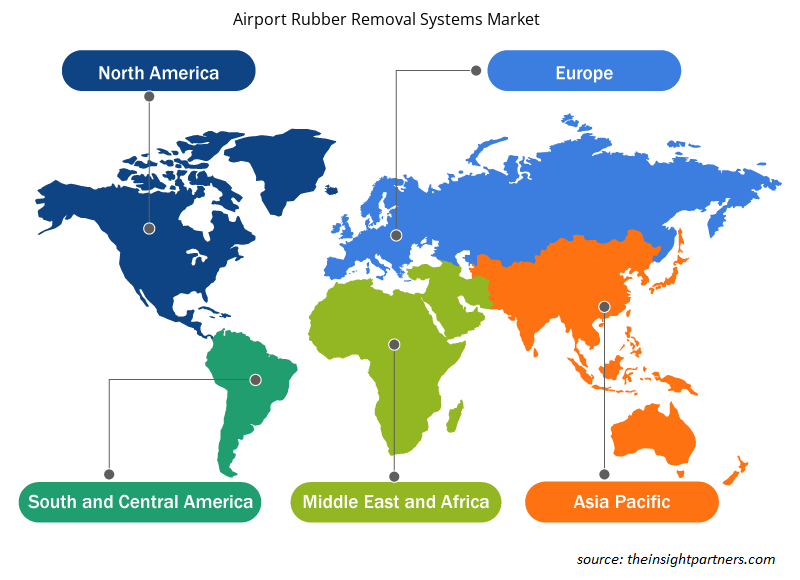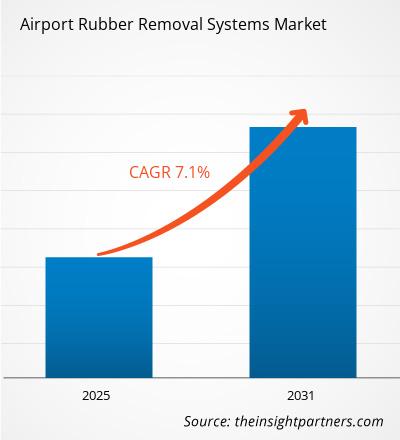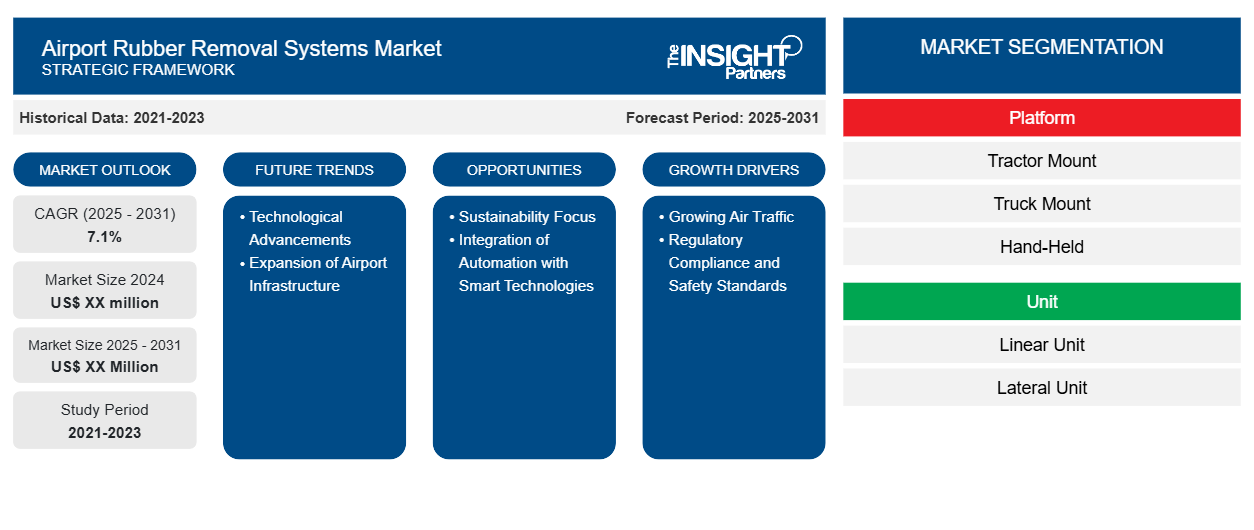Der Markt für Gummientfernungssysteme an Flughäfen wird voraussichtlich von 2023 bis 2031 eine durchschnittliche jährliche Wachstumsrate von 7,1 % verzeichnen, wobei die Marktgröße von XX Millionen US-Dollar im Jahr 2023 auf XX Millionen US-Dollar im Jahr 2031 wachsen wird.
Der Bericht ist segmentiert nach Plattform (Traktormontage, LKW-Montage, Handgerät); Einheit (Lineareinheit, Lateraleinheit); Anwendung (Verkehrsflughafen, Militärflugplatz). Die globale Analyse ist weiter auf regionaler Ebene und nach wichtigen Ländern aufgeschlüsselt. Der Bericht bietet den Wert in USD für die oben genannte Analyse und Segmente.
Zweck des Berichts
Der Bericht „Airport Rubber Removal Systems Market“ von The Insight Partners zielt darauf ab, die aktuelle Situation und das zukünftige Wachstum sowie die wichtigsten treibenden Faktoren, Herausforderungen und Chancen zu beschreiben. Dies wird verschiedenen Geschäftspartnern Einblicke geben, wie zum Beispiel:
- Technologieanbieter/-hersteller: Um die sich entwickelnde Marktdynamik zu verstehen und die potenziellen Wachstumschancen zu kennen, damit sie fundierte strategische Entscheidungen treffen können.
- Investoren: Durchführung einer umfassenden Trendanalyse hinsichtlich der Marktwachstumsrate, der finanziellen Marktprognosen und der Chancen entlang der Wertschöpfungskette.
- Regulierungsbehörden: Zur Regulierung von Richtlinien und Überwachungsaktivitäten auf dem Markt mit dem Ziel, Missbrauch zu minimieren, das Vertrauen der Anleger zu bewahren und die Integrität und Stabilität des Marktes aufrechtzuerhalten.
Marktsegmentierung für Flughafen-Gummientfernungssysteme
Plattform
- Traktorhalterung
- LKW-Montage
- Handgerät
Einheit
- Lineareinheit
- Laterale Einheit
Anwendung
- Kommerzieller Flughafen
- Militärflugplatz
Geographie
- Nordamerika
- Europa
- Asien-Pazifik
- Süd- und Mittelamerika
- Naher Osten und Afrika
Geographie
- Nordamerika
- Europa
- Asien-Pazifik
- Süd- und Mittelamerika
- Naher Osten und Afrika
Passen Sie diesen Bericht Ihren Anforderungen an
Sie erhalten kostenlose Anpassungen an jedem Bericht, einschließlich Teilen dieses Berichts oder einer Analyse auf Länderebene, eines Excel-Datenpakets sowie tolle Angebote und Rabatte für Start-ups und Universitäten.
-
Holen Sie sich die wichtigsten Markttrends aus diesem Bericht.Dieses KOSTENLOSE Beispiel umfasst eine Datenanalyse von Markttrends bis hin zu Schätzungen und Prognosen.
Wachstumstreiber auf dem Markt für Gummientfernungssysteme an Flughäfen
- Wachsender Flugverkehr: Der wachsende Flugverkehr und die zunehmende Flugzeuggröße führen zu einer hohen Gummiablagerung auf den Start- und Landebahnen. Die zunehmende Flugabfertigung zusammen mit der Landung größerer Flugzeuge setzt Flughäfen dem Problem einer erhöhten Gummiablagerung aus.
- Einhaltung von Vorschriften und Sicherheitsstandards: Flughäfen müssen im Allgemeinen gemäß den von den Luftfahrtbehörden, einschließlich der FAA, festgelegten, recht hohen Standards arbeiten. Zu diesen Vorschriften gehört, dass sie häufige Start- und Landebahnen für die Entfernung von Gummi vorsehen, um ausreichend Reibung zu gewährleisten, die Aquaplaning-Vorfälle verhindern kann.
Markttrends für Gummientfernungssysteme an Flughäfen
- Technologischer Fortschritt: Die meisten Technologien zur Gummientfernung, wie z. B. Hochdruck-Wasserstrahlsysteme, bieten zahlreiche Möglichkeiten für effizientere und umweltfreundlichere Lösungen auf Flughäfen.
- Ausbau der Flughafeninfrastruktur: Da viele Länder sich auf die Entwicklung und Verbesserung ihrer Flughafeninfrastruktur konzentrieren, steigt der Bedarf an effizienter Wartung der Start- und Landebahnen. Diese Entwicklung eröffnet Unternehmen, die Gummientfernungssysteme betreiben, die Möglichkeit, neue Märkte zu erschließen und Dienstleistungen anzubieten.
Marktchancen für Gummientfernungssysteme an Flughäfen
- Fokus auf Nachhaltigkeit: Nachhaltige Flughafenbetriebe entwickeln sich zunehmend mit dem Fokus auf die Reduzierung des ökologischen Fußabdrucks. Dazu gehören schonende Methoden zur Gummientfernung, die nicht viel Wasser verbrauchen und im Allgemeinen keine schädlichen Chemikalien enthalten, gemäß internationalen Nachhaltigkeitskriterien.
- Integration von Automatisierung mit intelligenten Technologien: Die Integration von Automatisierung im Einklang mit intelligenten Technologien wird auf Flughäfen mittlerweile immer üblicher. Von Gummientfernungssystemen – die mit minimalem menschlichen Eingriffsbedarf verwendet werden können und dadurch durch eine erhebliche Gesamtreduzierung des Personals deutlich an Effizienz gewinnen und Kosten senken können.
Regionale Einblicke in den Markt für Gummientfernungssysteme an Flughäfen
Die regionalen Trends und Faktoren, die den Markt für Flughafen-Gummientfernungssysteme während des gesamten Prognosezeitraums beeinflussen, wurden von den Analysten von Insight Partners ausführlich erläutert. In diesem Abschnitt werden auch Marktsegmente und Geografie für Flughafen-Gummientfernungssysteme in Nordamerika, Europa, im asiatisch-pazifischen Raum, im Nahen Osten und Afrika sowie in Süd- und Mittelamerika erörtert.

- Erhalten Sie regionale Daten zum Markt für Gummientfernungssysteme für Flughäfen
Umfang des Marktberichts über Gummientfernungssysteme an Flughäfen
| Berichtsattribut | Details |
|---|---|
| Marktgröße im Jahr 2023 | XX Millionen US-Dollar |
| Marktgröße bis 2031 | XX Millionen US-Dollar |
| Globale CAGR (2023 - 2031) | 7,1 % |
| Historische Daten | 2021-2022 |
| Prognosezeitraum | 2024–2031 |
| Abgedeckte Segmente |
Nach Plattform
|
| Abgedeckte Regionen und Länder |
Nordamerika
|
| Marktführer und wichtige Unternehmensprofile |
|
Dichte der Marktteilnehmer für Gummientfernungssysteme an Flughäfen: Auswirkungen auf die Geschäftsdynamik verstehen
Der Markt für Gummientfernungssysteme für Flughäfen wächst rasant, angetrieben durch die steigende Nachfrage der Endnutzer aufgrund von Faktoren wie sich entwickelnden Verbraucherpräferenzen, technologischen Fortschritten und einem größeren Bewusstsein für die Vorteile des Produkts. Mit steigender Nachfrage erweitern Unternehmen ihr Angebot, entwickeln Innovationen, um die Bedürfnisse der Verbraucher zu erfüllen, und nutzen neue Trends, was das Marktwachstum weiter ankurbelt.
Die Marktteilnehmerdichte bezieht sich auf die Verteilung der Firmen oder Unternehmen, die in einem bestimmten Markt oder einer bestimmten Branche tätig sind. Sie gibt an, wie viele Wettbewerber (Marktteilnehmer) in einem bestimmten Marktraum im Verhältnis zu seiner Größe oder seinem gesamten Marktwert präsent sind.
Die wichtigsten Unternehmen auf dem Markt für Gummientfernungssysteme an Flughäfen sind:
- Blasters, Inc.
- Blastrac
- DE Gemmill
- Foster Contracting Holdings Limited
- Hog Technologies, Inc.
Haftungsausschluss : Die oben aufgeführten Unternehmen sind nicht in einer bestimmten Reihenfolge aufgeführt.

- Überblick über die wichtigsten Akteure auf dem Markt für Gummientfernungssysteme für Flughäfen
Wichtige Verkaufsargumente
- Umfassende Abdeckung: Der Bericht deckt die Analyse von Produkten, Dienstleistungen, Typen und Endbenutzern des Marktes für Gummientfernungssysteme für Flughäfen umfassend ab und bietet einen ganzheitlichen Überblick.
- Expertenanalyse: Der Bericht basiert auf dem umfassenden Verständnis von Branchenexperten und Analysten.
- Aktuelle Informationen: Der Bericht stellt durch die Abdeckung aktueller Informationen und Datentrends Geschäftsrelevanz sicher.
- Anpassungsoptionen: Dieser Bericht kann angepasst werden, um spezifische Kundenanforderungen zu erfüllen und die Geschäftsstrategien optimal anzupassen.
Der Forschungsbericht zum Markt für Gummientfernungssysteme an Flughäfen kann daher dabei helfen, die Branchensituation und Wachstumsaussichten zu entschlüsseln und zu verstehen. Obwohl es einige berechtigte Bedenken geben kann, überwiegen die allgemeinen Vorteile dieses Berichts tendenziell die Nachteile.
- Historische Analyse (2 Jahre), Basisjahr, Prognose (7 Jahre) mit CAGR
- PEST- und SWOT-Analyse
- Marktgröße Wert/Volumen – Global, Regional, Land
- Branchen- und Wettbewerbslandschaft
- Excel-Datensatz
Aktuelle Berichte
Erfahrungsberichte
Grund zum Kauf
- Fundierte Entscheidungsfindung
- Marktdynamik verstehen
- Wettbewerbsanalyse
- Kundeneinblicke
- Marktprognosen
- Risikominimierung
- Strategische Planung
- Investitionsbegründung
- Identifizierung neuer Märkte
- Verbesserung von Marketingstrategien
- Steigerung der Betriebseffizienz
- Anpassung an regulatorische Trends























 Kostenlose Probe anfordern für - Markt für Flughafengummientfernungssysteme
Kostenlose Probe anfordern für - Markt für Flughafengummientfernungssysteme